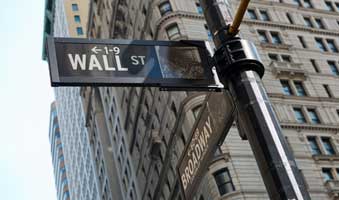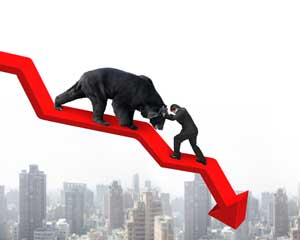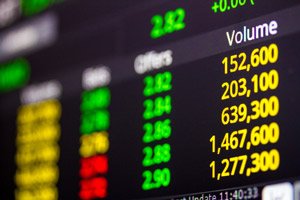When it comes to the stock market, everything’s always all good... until it isn’t.
And it’s been all good: U.S. stocks have been rallying for nine years, making successive all-time highs, with only sporadic bouts of profit-taking by the Nervous Nellies along the way.
But now, some huge investors – marquee names - are getting nervous.
And they’re letting people know about it, too...
Between them, these giants are pushing around close to $1.7 trillion in capital – more than enough for them to be able to make waves wherever they go.
I’m going to show you what to do if these whales are right; they just might be...
Meet the (Very Wealthy and Powerful) Bears
Ray Dalio, founder of Bridgewater Associates LP, the world’s largest hedge fund with more than $150 billion under management, believes the “magnitude” of the next downturn will be epic. “We fear that whatever the magnitude of the downturn that eventually comes, whenever it eventually comes, it will likely produce much greater social and political conflict than currently exists,” he recently said.
Former “Bond King” Bill Gross, founder of PIMCO LLC and now legendary portfolio manager at Janus Henderson, says, we’re at the highest risk levels since 2008 because “investors are paying a high price for the chances they’re taking.”
 Naturally, founder and CEO of DoubleLine Capital Jeff Gundlach - the new “Bond King” - advises “moving toward the exits.” Gundlach’s reducing his positions in junk bonds, emerging-market debt, and lower-quality investments, because he believes investor sentiment will turn negative. “If you’re waiting for the catalyst to show itself, you’re going to be selling at lower prices,” he told Bloomberg.
Naturally, founder and CEO of DoubleLine Capital Jeff Gundlach - the new “Bond King” - advises “moving toward the exits.” Gundlach’s reducing his positions in junk bonds, emerging-market debt, and lower-quality investments, because he believes investor sentiment will turn negative. “If you’re waiting for the catalyst to show itself, you’re going to be selling at lower prices,” he told Bloomberg.
Wall Street icon Carl Icahn, who regularly loads up on stocks and hits it out of the park, warns he isn’t seeing opportunities given how much stock prices have run up. “I really think now, I look at this market and you just say, ‘look at some of these values,’ and you have to wonder,” he lamented in a CNBC interview in June.
Oaktree Capital founder Howard Marks has been talking about “too-bullish territory.” The billionaire warns “aggressive investors are ‘engaging in willing risk-taking, funding risky deals, and creating risky market conditions.’”
Legendary hedge fund guru George Soros, who in 1992 “broke the Bank of England” and pocketed more than $1 billion doing it, recently sold stocks and bought gold… after a near 10-year hiatus. Just to give you an idea, the last time Soros made a big play was in 2007, when he placed bearish trades on housing in the run-up to the meltdown.
Appaloosa Management’s David Tepper warns investors to stockpile some cash and says he’s “on guard.”
“Everything is expensive and we are late in the business cycle," Sebastien Page, head of asset allocation at T. Rowe Price, said in an interview with Bloomberg. "That introduces fragility for risk assets, and there isn’t much buffer."
So, that’s a lot of negativity. But don’t let it ruin your day. Do this instead...
How to Stay Invested and Sleep at Night
[mmpazkzone name="in-story" network="9794" site="307044" id="137008" type="4"]
Individual investors would be foolish to not heed warnings from so many successful investors.
But that doesn’t mean sell everything. In fact, no one’s saying that, and that’s not a good idea.
 Sure, the market is in nosebleed territory, but it has been for a long time, and it still manages to keep going higher.
Sure, the market is in nosebleed territory, but it has been for a long time, and it still manages to keep going higher.
If it keeps going higher, the last place investors would want to be is on the sidelines.
Too many would-be investors are on the sidelines and have been there since the market started rallying back in 2009, perpetually afraid the rising market is due for a big correction.
So, is the next “Big One” coming? It might be. But, then again, it may only look scary up here.
Here’s what you want to do about it... and the way I’d play it: have sell orders ready and waiting.
That means putting down “sell-stop” orders on your positions.
If outright selling overtakes the market, it could be too late to take good profits you’re sitting on.
When markets fall they can do so hard and fast, leaving invested individuals with nothing more than hope that their bleeding positions will find a bottom and bounce back into profitability.
I don’t play the game that way.
I always use stop-loss orders to exit my positions with plenty of profits. I want to sell my shares if they drop to a level I’m uncomfortable with.
That level is different for every stock.
I use two metrics to determine where to place my stops.
First, I look at the stock’s chart. I look for “support” below where the stock’s trading currently.
 Support is a price level where the stock saw a lot of buying. It could be a level where the stock came down to in the past before bouncing back up. Or, it could be a level where there was a lot of sideways movement in the stock before it took off higher. Those levels are indicative of past buying - that’s why they’re called “support levels.”
Support is a price level where the stock saw a lot of buying. It could be a level where the stock came down to in the past before bouncing back up. Or, it could be a level where there was a lot of sideways movement in the stock before it took off higher. Those levels are indicative of past buying - that’s why they’re called “support levels.”
If the stock breaks below support, you have to figure other investors, who bought the stock at a lower price and saw it break through a resistance level, are also watching that happen.
At the same time, you have to reckon other investors might’ve bought at that support level, or even higher, and are now watching the stock come down.
Either way, they could be freaking out and thinking hard about an exit if it can’t hold support.
In that way, support levels are psychological levels for investors - and especially for traders.
I don’t put my stop orders down right at support levels. Instead, I put them down about 2% to 5% (not percentage points) below where I see support. That’s because aggressive traders often try and push stocks down through support levels so stop-loss orders resting there get triggered. Guess who’s buying your shares from you then? Those big aggressive traders, that’s who. I know, because I used to trade that way in my hedge funds, and believe me, it is a very lucrative game to play.
But, if there’s something wrong with my stock or with the market that breaks support by 2% to 5%, I want out.
The other consideration you have to have when using a stop-loss order is to let the stock move.
If you put a stop-loss order down too close to where the stock is trading, it will probably get hit and you’ll sell your stock, and all too often you’ll be left to watch it rocket higher without you.
I look at the stock’s range of motion over a month. I want to know what kinds of swings up and down it makes. Whatever that range is (say, a 5% range or a 10% range), I’ll place my stop just outside that range, maybe 6% or 11% below where the stock’s trading.
For me, if my stock’s going up and up, and the obvious support is getting further and further away (meaning it’s way below where the stock is now), I’ll keep raising my stop, so I get out if the stock breaks below the range I’ve given it to bounce in.
I always raise my stops after a good up-move.
First and foremost, I look for a new support level; that’s where I prefer to have my stops, just below there. If the stock’s been on a tear, and there’s no real support below where the stock’s come from, I’ll raise my stop to just below the outside range I’ve seen the stock bounce around in.
In other words, if the stock’s going pretty much straight up and isn’t bouncing much, I’ll have a tighter stop because there isn’t much bouncing and not much of a range to measure. That’s okay, because a stock that goes up like that can come down in a hurry too, and I want to capture as much profit as I can.
Using stops is about saving money on the downside and ringing the cash register on the way up.
If your stock has a big move up and you get stopped out with a big profit, that doesn’t mean you can’t buy back into the stock.
No sweat. I do that all the time.
Once you ring the register, you’ve then got fresh capital to apply. You can apply it back into the stock you just got stopped out of if you feel the stock’s going higher. So what if you have to pay up a little more? The stock’s rising, it’s doing what you want it to do.
Just like everyone, I listen to what big investors throwing around billions of dollars are saying and doing. In the end, I do my own thing. But, it would be foolish not to understand what they’re thinking, what they’re investing in or getting out of. It’s information. Use it.
And with stop-loss orders, you can be in the game and sleep at night without worrying if the sky falls on the market tomorrow, or next year, or never.
Shah Gilani is the editor of Zenith Trading Circle. His readers have had the opportunity to make average gains of 35% per day (including partial closeouts) playing his recommendations. His win record is incredible, and you can have the chance to see how it’s done. Just click here to check it out...
Follow Shah on Facebook and Twitter.
About the Author
Shah Gilani boasts a financial pedigree unlike any other. He ran his first hedge fund in 1982 from his seat on the floor of the Chicago Board of Options Exchange. When options on the Standard & Poor's 100 began trading on March 11, 1983, Shah worked in "the pit" as a market maker.
The work he did laid the foundation for what would later become the VIX - to this day one of the most widely used indicators worldwide. After leaving Chicago to run the futures and options division of the British banking giant Lloyd's TSB, Shah moved up to Roosevelt & Cross Inc., an old-line New York boutique firm. There he originated and ran a packaged fixed-income trading desk, and established that company's "listed" and OTC trading desks.
Shah founded a second hedge fund in 1999, which he ran until 2003.
Shah's vast network of contacts includes the biggest players on Wall Street and in international finance. These contacts give him the real story - when others only get what the investment banks want them to see.
Today, as editor of Hyperdrive Portfolio, Shah presents his legion of subscribers with massive profit opportunities that result from paradigm shifts in the way we work, play, and live.
Shah is a frequent guest on CNBC, Forbes, and MarketWatch, and you can catch him every week on Fox Business's Varney & Co.



